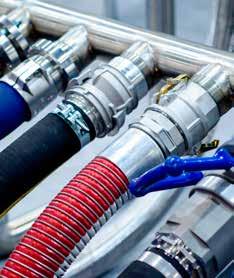
4 minute read
How untangling hoses saved £26,000
Colin MacMillan Technical Specialist, Industrial Hose
Hoses can tie-up money. Leak cash. Spray budgets up the wall. And their associated health and safety considerations can easily trip people up. That’s why a concerned engineering manager called in ERIKS to take a close look at the hose assets of a major Scottish Malt Whisky distillery.
Advertisement
A leak of any fluid from a worn or damaged hose is a problem. When what’s leaking is Malt whisky, at 2-3 litres per minute, it’s not just a problem but serious money down the drain. In the same way, a hydraulic hose burst is always an injury risk, due to the pressure the fluid is under. But when the hose lacks burst protection, and is next to a dedicated walkway, then the risk becomes an accident waiting to happen.
An exercise which began with a visual skim survey continued with a 14-day in-depth inspection of 364 hoses. And it revealed many more issues that were wasting the customer’s money and reducing their operational efficiency on a daily basis.
Serious money down the drain
A site for sore feet
Site surveys can be challenging and timeconsuming at the best of times. During a global pandemic is not the best of times. Adding to the difficulties was the location of the customer’s site. Like many Scotch Malt whisky distilleries, it’s remote. When overnight accommodation is hard to find because of a pandemic, it seems more remote than ever. Even on site, things didn’t get much easier. The site map provided was old, and the site had been updated and changed over a number of years. An in-depth knowledge of the number of hoses in use, or their locations wasn’t mapped to its fullest. The site covers 1½ by 2½ miles, and contains nearly 50 large warehouses, and had to be inspected entirely on foot. However, Colin MacMillan – the Technical Specialist from ERIKS Flow Control – couldn’t just wander at will. With the warehouses containing large VAT’s of premium quality whisky, security was tight and access not always easy. Even pointing out he wasn’t a risk because he preferred vodka to whisky didn’t help to open any doors for Colin.

Problems in the pipeline
The full survey took a total of 14 days, with support from ERIKS Industrial Hose Application Engineer Ian Glover. As well as the ‘red flag’ issues described opposite, a number of other problems and potential improvements were identified. These ranged from opportunities for better housekeeping and hose storage which would help to extend the life of the hoses, to recommendations for more appropriate fittings, to eliminate the safety risk of a fitting being blown from a hose. In at least one application, ERIKS’ specialists identified that the wrong hose was being used for the media it was transporting. A basic nitrile rubber hydraulic hose was being used for 28% caustic soda. This was steadily eroding the liner and creating a health and safety hazard. Hoses were also found with gouges, cuts, weathering and aging, putting them at risk of leaks and bursts.
To eradicate this going forward ERIKS are now also organising a full training schedule for not only the Hose Management system, but also best practices for housekeeping, correct hose fittings and H&S best practices. No loose ends
Reducing operational efficiency
Different areas of the customer’s site, and management of different functions within the process, were operating independently. This loose integration not only meant reduced site-wide best practice, and costly duplication of hose purchases. It also prevented the creation of a centralised asset register and a co-ordinated inspection and testing regime. Under ERIKS’ advice and guidance, a comprehensive hose asset register has now been put together, providing full visibility of all hose assets. An inspection and testing regime has also been established, which will increase efficiency and reduce the cost of hose asset management, not least by co-ordinating site visits. By also following predictive maintenance practices, the need for emergency breakdown repairs should be greatly reduced. And with all hose assets now correctly identified and tagged, in the event of a breakdown it will be easier to ensure the correct replacement is fitted. Or, if that’s unavailable, the next inspection will show that the replacement was temporary and the correct hose needs to be installed as soon as possible. Looking ahead ERIKS will potentially now hold consignment stock on site ready for use on the correct applications and also further reduce lead times and application downtime, delivering more added value and savings. By tying-up all these hose loose ends for the customer, ERIKS have established a comprehensive, efficient, cost-effective and safety-conscious hose asset management process. One which has delivered £12,000 of signed-off cost savings. With a further £14,000 in the process of being signed of as we go to print, as well as all the leaks now under control, with the value still to be calculated.


12,000 signed-off cost savings
Cheers to that. Or as they say in Scotland: Slàinte mhath.










